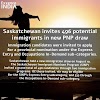last week Canada announced its 2020-2022 Migration Levels Plan as the coronavirus (COVID-19) emergency was raising.
In fact, the declaration was eclipsed by the major monetary and social disturbance that the coronavirus is having in Canada and abroad.
Here at home, Canada, much the same as most nations, seems headed towards a downturn. COVID-19 has prompted a value war between significant oil makers all around, and the crumbling cost of oil will have negative repercussions for Canada's economy.
Also, debilitated monetary action will sting almost every division with specific ones specifically, for example, the travel industry and neighborliness bearing noteworthy blows.
To obstruct the blows, the Bank of Canada reported a crisis slice to its medium-term financing cost, only multi week after it had just cut the rate. They may not be done, as certain investigators conjecture more slices might be expected to enable Canada's economy to endure the hardship.
Abroad, we have seen any semblance of highly sensitive situations, travel bans, and other remarkable occasions, for example, financial exchange crashes.
In fact, the declaration was eclipsed by the major monetary and social disturbance that the coronavirus is having in Canada and abroad.
Here at home, Canada, much the same as most nations, seems headed towards a downturn. COVID-19 has prompted a value war between significant oil makers all around, and the crumbling cost of oil will have negative repercussions for Canada's economy.
Also, debilitated monetary action will sting almost every division with specific ones specifically, for example, the travel industry and neighborliness bearing noteworthy blows.
To obstruct the blows, the Bank of Canada reported a crisis slice to its medium-term financing cost, only multi week after it had just cut the rate. They may not be done, as certain investigators conjecture more slices might be expected to enable Canada's economy to endure the hardship.
Abroad, we have seen any semblance of highly sensitive situations, travel bans, and other remarkable occasions, for example, financial exchange crashes.
 |
| exxence india |
Why 2020-2022 immigration Levels Plan bodes well in spite of COVID-19
Accordingly tumult inundates the world, it is justifiable that Canada's choice to welcome more than one million extra migrants throughout the following three years isn't the focal point of consideration right now.
In any case, the COVID-19 emergency can assist us understand why migration will be so urgent to Canada's economy pushing ahead.
Truly, Canada's economy looks set to contract in 2020. All things considered, one could make the contention that expanding migration right now isn't perfect since newcomers will show up in Canada when the work market will battle to retain them.
However, recent developments fill in as an update that Canada's migration strategies are to a great extent proactive in nature, and since the late 1980s, the choice of the quantity of migrants to welcome has been to a great extent isolates from monetary conditions on the ground.
While Canada invites immigrants to help fill prompt employment opening, its migration approaches are additionally intended to reinforce the nation's financial standing years and decades from now. This implies regardless of whether newcomers show up during a monetary downturn, Canada anticipates that similar newcomers should be impetuses for financial development later on.
A major reason for this is that all of Canada’s nine million baby boomers will reach retirement age by the end of this decade. Since Canada has a low birth rate, it is depending on migration to drive most of its work power development.
Work power development is one of two different ways to develop the economy, with the other route being to utilize the work power all the more profitably.
Hence, it still makes sense to admit high levels of newcomers even during periods of economic distress. While immigrants arriving in Canada in 2020 may face more difficulties than usual in finding work that aligns with their skills, education, and work experience, they will soon face the prospects of working in a country where the supply of labour will be significantly constrained as more baby boomers leave the workforce. This means that such immigrants will likely see more employers competing for their services, which would result in much better employment outcomes and salaries.
“Tap on, tap off” turned off in late 1980s
The proactive proportion of inviting elevated levels of newcomers in any event, during downturns is a genuinely new one in Canadian history.
Up until the late 1980s, Canada utilized a “tap on, tap off” approach to immigration levels. It welcomed higher levels of newcomers when the economy was strong, and reduced immigration during recessions. However, it moved away from this approach in the late 1980s after determining it needed to sustain high levels of immigration to alleviate the economic and fiscal strain that was soon to come due to its rapidly aging population and low birth rate. Since then, Canada has maintained high levels even during several recessions including the major one that occurred in 2008-09.
It can also be argued that a short-term benefit of welcoming immigrants during periods such as what Canada is experiencing today still helps the economy in the short-run since newcomers will help to stimulate demand in Canada through the purchase of goods and services which will help to relieve some of the economic stress being caused by the coronavirus crisis.
Reporting an eager migration levels plan during such an emergency might not have seemed, by all accounts, to be perfect planning superficially, in any case, by and by, the planning of the declaration will demonstrate unimportant.
The present higher movement levels, despite the fact that we are encountering a coronavirus emergency and financial torment, will bring about greener monetary fields tomorrow as the deluge of newcomers adds to Canada's economy as laborers, buyers, and citizens.












1 Comments
It was such informative, Thanks for sharing. Wants to Immigrate Canada With Easy and Successfull In India, Contact the best visa consultant in delhi - novusimmigrationdelhi
ReplyDelete